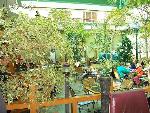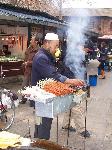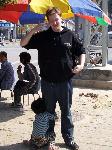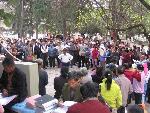- Getting around Lijiang. Dont stay in the Old Towns more than 2 days, there is nothing to do. KRISS Oct 9, 2013 05:46
- 2013 Beijing Temple Fair BENNYLAU Feb 26, 2013 03:29
- Malaysian traveling from KUL - LAX vis Shanghai PVG ZATI_DY Jan 3, 2013 20:15
South for the Winter
- Views: 5868
- |Vote: 1 0
- |Add to Favorites
- |Recommend to Friends
By Plane or Train?
When the icy fingers of Winter whip the last leaves from the trees and the world turns bare and brown, nothing assuages the eyes and soul more than a trip to the City of Eternal Spring. Migrating south to find a hint of color and the soft touch of sunshine promises refuge and respite from the dreariness and cold plaguing the northern climates.
So where is this City of Eternal Spring? Well, it’s better known as Kunming, the capital city of the Yunnan Province, in the south and west of China.
Our trip to Kunming began with tinny exhaustion; the exhaustion of seeing and hearing the world as if it's a reflection in a shallow bowl. It was cold in Tianjin, my home city, and we were weary from months of work and no play. We were eager to get away. After comparing the prices between the train and the airline, we botched our plans for taking the train south and opted to fly instead. A rush decision, but it well worth it. Within two hours—instead of twenty or more, we were transported to another world.
Spring in the City
Kunming, seen for barely a day, was a heaven in its smells. The air, despite encasing itself in a very large city, is clean. It smells fragrant, like pine and verdant hills; like mossy florals. It was January, and yet greenery bared itself still: on the tree-lined boulevards, in gardens, and on the surrounding hills. Flowers were still on trees. Pine and palm grow side-by-side in this sub-tropical-albeit-high-altitude city. Clouds toss overhead and our first day was mostly overcast, but they were the clouds of weather, produced by the tensile sign-language of the moon and the sea, not the billowing, poisonous exhausts of human industry. This, in itself, makes for a vacation. And though Kunming lies in the relative middle of the Yunnan Province, it by no means alludes to the range of terrain found within it. The Yunnan cradles Rainforest in the south, volcanoes in the west, the snow-capped tail of Tibetan peaks in the north and fertile, ‘Eternal Spring’ in the mid- and eastern regions. The Province contains over half of all China's plant and animal species.
The Marketplace
On our first day we walked through the local Muslim market just off Nanping Lu, wandering within the warren of shops and food-sellers and ware-mongers. For a while the market picked up a few blocks of ash trees with stunted limbs and behind those, an emerald-green long-house building, row after row of aging, flaking, rotting wood; lattice windows with broken panes, peeling paint. It was beautiful and sorrowful. Restored, the building would simply be a mockery, a show, an icon for tourists. But withering, aging...it remained genuine but sad. Stunted, like the trees. Forgotten, but still used. A cast-off era.
In the market people fried potatoes and tofu, spun sugar, sold seeds and nuts and grain and vegetables. You could buy slices of a root that looked, both outside and in, like jicama, but tasted drier and rootier. They sold steamed corn, soups with noodles, skewers of meat and vegetables awaiting a plunge in boiling oil or a grill on the narrow, smoking barbeques. There were glutinous-rice tortillas grilled to puffed and steaming, then slathered with a plum sauce, a peanut sauce and a chili sauce and rolled up. Exotic fruits and vegetables, in odd shapes and vibrant colors, beckoned from the heaping baskets of street sellers and market stalls.
White hats bobbed around the marketplace showcasing Kunming's muslim population. The Muslims arrived in the 13th Century, after the Mongols under Kublai Khan invaded and crushed the autonomous rule of the region. The Muslims brought in traders, builders, and scholars over the southern leg of the Silk Road, accessing Myanmar, Laos, and Thailand. In addition to Muslims, the whole of the province hosts over 20 ethnic minorities and languages that have lived in the area for thousands of years.
Internal Struggle
There are begging children in the street, more than I've ever seen in the larger metropolises, which is surprising. They single out Westerners especially (of which there are many in this city), and keep pace with us as we walk, their begging-bowl fastened against our legs as if by magnetism, and it's difficult to tell if they're genuinely desperate or pawns in a ruse, well-trained. Both exist (the genuinely desperate and the pawns), perhaps in equal measure. I give to both, because I can't tell which is which and a child should never be accountable to cruelty; either the cruelty of desperation or the cruelty of those willing to use children to earn money. In equal measure, I support and subvert corruption.
Eternal Memories
In the afternoon we went to Green Lake Park. The park was virtually empty of tourists and buzzing with local life. Birds swam serenely on the placid, dark water. Bamboo groves, banana palms, coconut palms, magnolia framed the winding paths. Tulips happily bobbed in the breeze. People strolled or sat or soaked up the sun. Families meandered hand in hand, their children playing. The conical hats of flower planters poked through the flora; secretive huddles of old men and women around their cards or chess idled through the afternoon hours. A crowd of 100 or more had gathered under a grove of trees around a group of musicians. People began singing together and dancing to the hollow, plaintive whine of the flutes and the longing twang of the strings, their voices ululating in an otherworldly pitch to the earthy, natural tones of the instruments.
Ethnicities abounded, though I couldn't tell which was which and who was who. The traditional clothing was a giveaway, but also the deeper angles and colors of their faces; their rounder and darker eyes. There was one woman I couldn't stop staring at: she had a black cloth, like a turban, wound around her head and chin and neck; she wore velveteen balloon pants and a skirt with a turquoise apron. She had supple, smooth skin, deep-set eyes that rolled over round cheekbones and the lines of her face gathered like curtains around her mouth and eyes, framing the theatre of her face. I liked watching her watch her grandchildren as they played on the carnival toys. I wondered what her life was like—what she was seeing through her eyes as I looked at her through mine.
Information
Getting There:
Airfare Beijing to Kunming: 800RMB
Getting Around:
Local Bus 1.5RMB(#5 takes you up and down the main thoroughfare)
Taxi (starts at 6RMB)
Go to City Café to book tickets to ANYWHERE—bus, air, or train, local or long-distance. They are friendly, efficient, prompt and helpful and cheaper than other of the many trip-booking kiosks nearby.
Staying There:
We stayed at the Camellia Hostel for 50RMB/night. The Camellia also has a big hotel, but the hostel sits just next door and is clean and friendly.
The City Café also offers great accommodation but even greater food.









 Copyright © 1998-2026 All rights reserved.
Copyright © 1998-2026 All rights reserved.
1.
Jan 29, 2012 10:01 Reply
Mr.SAL OBAID from USA said:
I loveed reading your review, poetic language,and beautiful description.I am married to a Chinese writer, and planing a trip to Kunming, like to play a round of golf there.wonder what is your occupation and education?.did you take a photo for the lady you described so nicely?
2.
Aug 23, 2007 04:54 Reply
JOANNEL said:
Hey Stocktov, why was this review so short- was looking forward to reading your poetic adventures in Yunnan, but alas it was all too short- but still another very good read,
thank,
Jo
3.
Apr 23, 2007 10:45 Reply
WIZARD1982 said:
find a time to travel in southeast china, like shantou, hainan, that would be different experiences, shantou for meal, hainan for view, of course travel them during the summer, but be careful, quite hot, but i am sure you would not regret if you find a nice guide =P